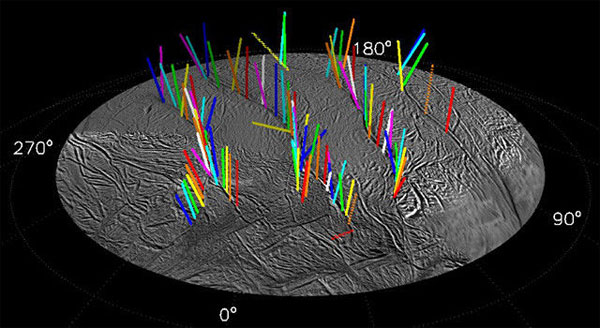Hundreds of water circuits are spraying on Saturn's moon
Scientists at the US Aeronautics and Space Agency (NASA) have identified more than 100 geysers on Saturn's moon Enceladus.
>>>Detecting sea water on Moon Enceladus of Saturn
Based on data sent from NASA's Cassini spacecraft, the team identified 101 separate geysers on Enceladus' frozen surface. Their analysis raises the possibility of liquid water coming from the submarine to the surface.

It is likely that there is water in the liquid state from the underground sea sprayed onto the surface
For about seven years, Cassini's cameras surveyed the southern pole of Enceladus - the only geological valley ever found that had four cracks and small ice-particle sprays with water vapor over the past 10 years.
The survey results are a diagram of 101 sprays on those cracks and each injection coincides with the hot spot. Research on this association shows the origin of geysers.
After seeing these geysers in 2005, scientists suspected that orbital Enceladus movement around Saturn could affect the operation of the injection circuits. Accordingly, the injection circuit can be converted to liquid or steam due to heat generated from friction.
The different images over the past time have shown the cracks said on closed and open allowing steam to escape from below. In the past, it was not clear which process affected the operation of the injection circuit. Comparisons from high resolution image data collected by heat sensors in 2010 help explain more about the operation of these injectors.
- Dinosaurs hatch eggs on hot water circuits
- New NASA research: Water and humans can be found on the Moon, so come back soon
- The poor invented the pesticide spraying machine from scrap
- Hundreds of UFOs left the moon?
- Search for water on the moon thanks to space exploration devices
- Where does the Moon's water come from?
- The moon contains water from its formation
- Semi-automatic sprinkler by homemade farmers
- Pesticide spraying robot
- Cool the earth with balloons
- Detecting water on the surface of the Moon
- Science may have found water right on our Moon
 Van Allen's belt and evidence that the Apollo 11 mission to the Moon was myth
Van Allen's belt and evidence that the Apollo 11 mission to the Moon was myth The levels of civilization in the universe (Kardashev scale)
The levels of civilization in the universe (Kardashev scale) Today Mars, the sun and the Earth are aligned
Today Mars, the sun and the Earth are aligned The Amazon owner announced a secret plan to build a space base for thousands of people
The Amazon owner announced a secret plan to build a space base for thousands of people